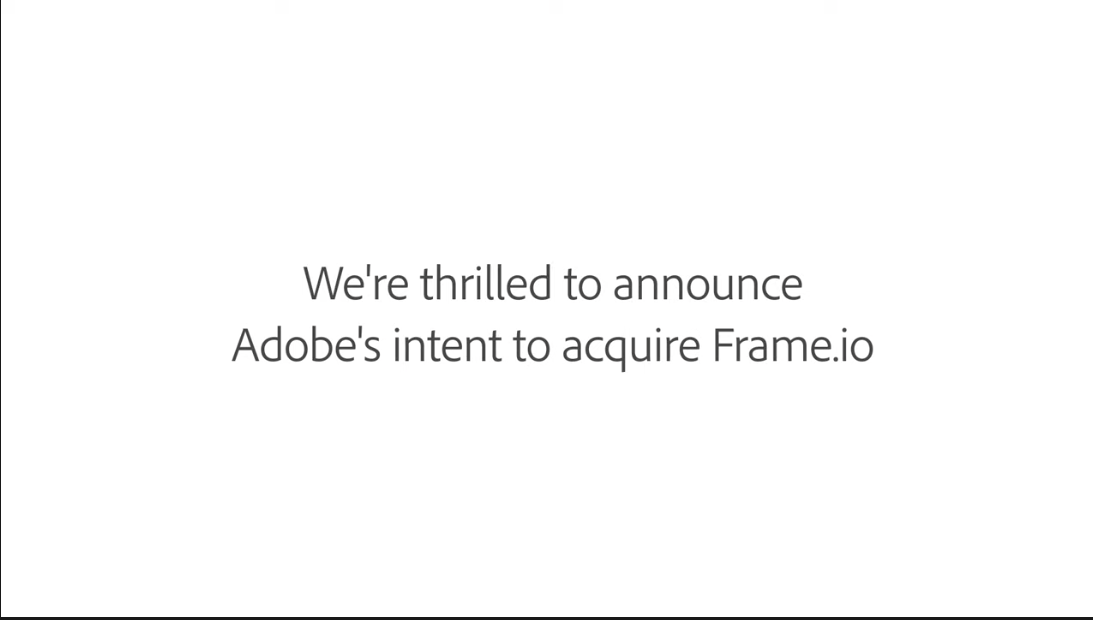How much collaboration does Adobe want? $2.775 billion dollars’ worth…so far. The creative and experience giant announced a definitive agreement to acquire video workflow and production collaboration solution, Frame.io in a $1.275 billion deal. Add that onto the $1.5 billion dollar deal for Workfront which was completed in December 2020…you’ve got nearly $3 billion that says collaboration IS the future. At least the future of both marketing and creative work. But…I like to think that this is core to the vision of where Adobe is heading.

Predictably, there is a video…
So now the brass tacks: The deal brings some 100 million Frame.io users more deeply into the tools many are already using like Adobe’s Premiere Pro and After Effects. Frame.io offers video editors and production stakeholders the ability to streamline everything from collaboration to approvals in a cloud-first workflow environment. Through key partnerships with industry leading hardware solutions, Frame.io offers a real-time camera to cloud secure footage upload solution that, when viewed in the totality of the Adobe video production suite, can extend from camera to cloud to completion in a fairly seamless and collaborative manner.
A great deal of Frame.io’s value proposition is wrapped in the idea of taking the pain, inefficiency and lag out of video production. As someone who has waited for hard drives to be shipped around the world (and one odd incident of tape, drives and a midnight run across the border into Mexico...don't ask) before raw footage can be reviewed let alone edited…the idea of fast, reliable and secure access to footage from camera to editing is worth its weight in gold. Then...if you start promising me that the workflows can extend all the way through the always painful gauntlet of approvals, suggestions and general frame by frame nitpicking…well…now I’m just blushing from all this excitement.
Yes. The Adobe pickup of Frame.io adds some valuable firepower to the video suite. And it hasn’t been a secret that a great deal of innovation attention has been paid to expanding and enhancing Adobe’s footprint in the world of video which extends well into 3D, AR and VR now. But as I day-dream about it...that's just the starting point.
Similar to the Workfront pickup, Adobe identified a partner that deeply understands the work of their customers. With Workfront, it was a foundational understanding of what goes into the actual WORK of marketing and engagement. I see that same vein in this Frame.io acquisition. Frame.io isn’t just “some collaboration tool” …it is a production tool developed by post-production for post-production. It isn’t a random workflow…it is purposeful and intentional. It is unapologetically for the makers, creators and do-ers. And that's pretty much become Adobe's new mantra.
What gets really interesting is when you extend the roadmap for collaboration beyond the integration of Workfront with solutions like Adobe Experience Manager and Adobe Assets, or beyond Frame.io with Premiere Pro. Imagine what happens when Adobe pulls the best of the best from BOTH Workfront AND Frame.io to reimagine what collaboration for creativity and experience really works like. THAT is the future that is worth at least $3 billion dollars in my mind.
There are plenty of competitors with collaboration and connectivity solutions. And there are oodles of solutions that address work coordination. My colleague Dion Hinchcliffe is one of THE leading experts in this space and has an exceptional ShortList outlining the leaders (hint: Workfront is already on it) in work coordination. But as a marketer, there is something I can say for certain: there is something just a bit different about the work of marketing and the work of creators. This is why tools like Workfront, Asana and Frame.io are as popular with creators as they are. Like the memes say…they just “get” us.
Only time will tell how far collaboration will connect the two sides of the Adobe coin—a coin that has had lines of demarcation segmenting Creative Cloud and Experience Cloud in a way that can feel like the gaps and fissures between marketing and creative teams themselves. If anything can bridge that gap in a meaningful way, it just might be collaboration and workflows. From camera to content consumption, once again, Adobe is just scooping up bigger chunks of territory in this shrinking land we call engagement.


